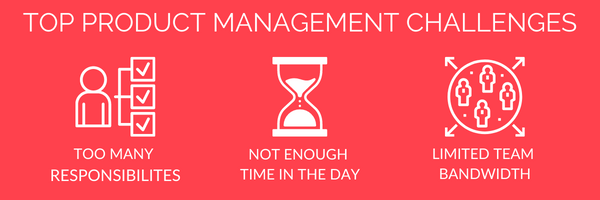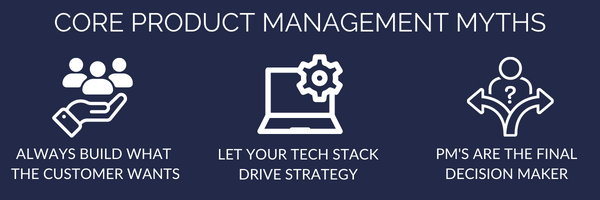Product management is a challenging role, no matter what industry you work in. But with great challenges come great opportunities, and most product managers thrive on taking on new tasks and solving difficult problems.
Product managers must live and breathe their product. They must assume the identity of the product, be invested emotionally, file more bugs than anyone else, and forget about the concept of vacation months prior to any launch.
As mobile grows and becomes a major investment for every company, the need for mobile product management is only increasing.
To understand specific hurdles people working in product face, we surveyed 500 product managers and asked them to weigh in on their biggest challenges.
The three most common challenges include:
- I have too many responsibilities.
- I don’t have enough time in my day.
- My team is too small.
Rather than simply responding to the top challenges, we want to share tips on how to approach them all.
The top challenges of product management

Too many responsibilities
Feeling overwhelmed with tasks and responsibilities can become paralyzing. If you feel like you have too much to do, it might be time to restructure your to-do lists in order to adjust the priorities of your responsibilities. Perhaps you rephrase your tasks as questions, or maybe you start following the 1-3-5 to-do list rule. Whatever you decide, be sure to constantly question the priority level of the work you must complete. Also, be transparent with your manager if you truly feel like you have too many responsibilities to manage.
Speaking up might spur a conversation around how to adjust your role to better fit your needs, or better yet, to bring in another team member to share your workload.
Not enough time in the day
We hear ya. You can’t get more hours in the day, so it’s important to use the ones you have as efficiently as possible. The key to rearranging your day to give yourself more time is to figure out which productivity method works for you, and to stick to it as much as possible.
Whether you need chunks of meeting-free time blocked off, work more efficiently in sprints, or find that Tuesdays are better spent working remotely, there are plenty of ways to hack your day to give you more time to get things done. LifeHacker has endless tips and practices to experiment with. Pick one you think might work for you and give it a shot!
Limited team bandwidth
Here’s the thing: No matter the size of your team, you will likely always feel as though you need another teammate (or five) to reach your goals. When you feel this way, it’s a good sign that you are setting stretch goals, which is what many teams should strive for.
But if you truly have resourcing issues, it’s always worth talking with your manager to understand your team’s hiring plan as your insight will be helpful in putting together a job description for your next teammate. If you’re in management, be sure to work directly with your teammates to figure out where your biggest resource constraints lie before asking for additional headcount.
Tips to overcome product management challenges
Level-up your mobile product management knowledge
As the digital transformation continues, strong mobile products are critical to overcoming business challenges, no matter the industry. This is why mobile-first offerings are on rise.
Mobile first doesn’t mean mobile only. It means that the product focus has shifted to prioritize mobile as the main consumer channel, with others coming secondary. Here are some ways to level up your mobile product management skills and knowledge to overcome challenges:
- Surround yourself with mobile to understand what makes a good experience good, and a bad experience bad. By immersing yourself in mobile, you’ll begin to intuitively recognize product experiences that are worth emulating, and will have an easier time brushing up on the basics.
- Use your device often. The best mobile product managers are always on top of new trends, and the best way to see what’s hot or not is to use your device(s) as often as you can. If you can’t explain what makes your favorite apps great from a technical, marketing, and product perspective, chances are you have some learning to do. The more you challenge what you like and dislike in the mobile experiences you use consistently, the better it will translate to how you build your product.
- Become an expert in mobile usability. Customer expectations shift dramatically depending on device. Whether you help your team build for iOS, Android, tablet, wearable, or all of the above, having a deep understanding of how to use specific mobile devices will keep you a step ahead. The more you know about customer usability expectations, the quicker you can make data-driven product decisions.
- Change your mindset to mobile-first. To take on the world of mobile product management and build world-class app and mobile experiences, the only way to think is mobile-first (more specifically, you could go one step further and start thinking “screen-first” or “platform-first,” depending on your needs). As mobile continues eating the web, many companies are beginning to take on the “mobile-first” mindset as their standard for designing new products and features. Is your company mobile-first? If yes, you should already be thinking this way (but there’s always room for improvement!). If not, be the change you wish to see across your company.
- Read. All the time. Every day. As much as you possibly can. Here are a few product and mobile-focused blogs recommended by your peers:
- Product Hunt
- Quora
- PM Subreddits
- Mind the Product
- Mobile App Management Blog by Apperian
- Apptamin Blog
- TechCrunch
Know the myths of product management
The path to success in product management is not a straight line. PMs have diverse backgrounds, ambiguous responsibilities, and varied definitions of what their role includes. Due to its murkiness, there are a few common myths that plague product management across industries and company size.
Here are a few common myths around product management, along with data to support truths and guidance around how to better understand the profession:

Myth #1: To make customers happy, always build what they ask for.
Customer feedback is incredibly valuable, but product managers must understand why people feel the way they do before acting on their feedback. By not making it a priority to ask for, listen to, and implement customer feedback in a constructive manner, companies are missing a huge opportunity to closely align their business with their customers’ wants, needs, and expectations—while still keeping their product roadmap aligned with business goals.
Tools like Alchemer Digital are here to help make the process easier.
Feedback is key, but you will be running in circles if you only follow customer recommendations to build your product roadmap. People often prescribe what they think they want, but there’s often a better solution that actually solves the underlying problem.
To get to the root of what changes are necessary, product managers need to dive deeper into understanding customers pain points as well as what gives them value. This means listening deeply to customer feedback and sentiment, and asking the right questions at the right places and times within your digital experience.
Myth #2: Product managers should let technical architecture drive the strategy.
Although tech stack should be considered as an influence, it’s more important to work within your constraints rather than against them.
Strategy ultimately needs to be driven by business goals, customer feedback, and tech stack together. It’s a game of trade-offs to figure out what can best serve your business goals and your customers.
Mobile PMs are responsible for determining the “why” behind every feature built. Once the “why” is fully fleshed out from a business and customer perspective, the best PMs then go to their engineering and design teams and ask, “How can we build this given our constraints?” rather than suggesting that the feature not be built given architecture limitations.
Myth #3: Product managers are ultimately the decision makers.
Product managers should be facilitators, but you should not make the final call on what is built. Instead, you should conduct customer research, ask great questions, and facilitate all aspects of the internal decision making process across teams. As a product leader, your goal is to constantly provide a better product to deepen engagement, grow your revenue, and delight your customers.
In order to do so, you need to listen—we mean really listen—to customer feedback. Far too often, companies don’t take action based on the feedback their customers provide, and instead make major product decisions in a vacuum. A lack of communication and implementation of customer feedback can affect brand loyalty and customers’ willingness to provide feedback in the future.
Continue reading
In this post, we only talked about the three most common product management challenges and some tips to overcome them. But in reality, there are many more challenges, myths, and tactics to address!
Ready to see Alchemer in action? Talk to a salesperson today!
Not quite ready yet? That’s ok too! Here are some additional resources to check out:
- Alchemer Digital: Learn how Alchemer Digital drives omni-channel customer engagement across digital properties.
- Customer Stories: See how organizations have used Alchemer to elevate their customer feedback programs and do more with feedback.
- Customer Feedback in the Digital Era: Read our e-guide on the importance of customer feedback amid Digital Transformation.




